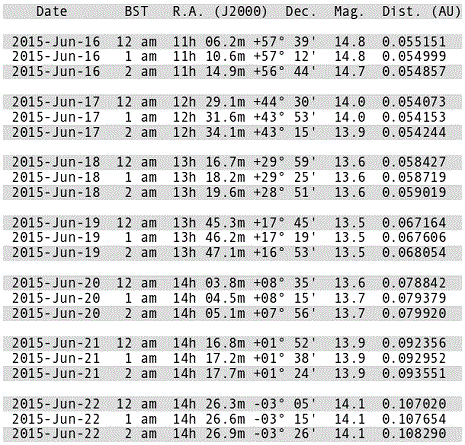1949 MA has a decidedly elliptical orbit that causes it to approach the Sun to within ⅔rds of the perihelion distance of planet Mercury before swinging out to aphelion beyond the orbit of Mars some 204 days later. Appropriately, 1949 MA was therefore named after Icarus of Greek mythology who flew too close to the Sun. For over half a century it held the distinction of being the asteroid that passes closest to the Sun until 2000 BD19 was discovered in 2000. Icarus was also the first asteroid to be observed with radar during its close approach of June 1968.
Classified as an Apollo asteroid, 1566 Icarus has an orbital resonance with Earth that causes it to make close approaches to our planet in the month of June at intervals of nine, 19 and 28 years, but never close enough to pose a threat of collision. The flyby of June 16th — 5,004,000 miles (8,053,000 kilometres) or 0.05383 astronomical units — is the nearest occurring between the years 1968 and 2090 (for comparison, the last close approach of 1996 was 9.4 million miles, or 39 times the Earth-Moon distance). Fortunately for observers in the British Isles, Icarus will be well placed for observation for this apparition and will reach magnitude +13.5 as it speeds across the northern night sky.
When to observe 1566 Icarus
Weather permitting, this fascinating asteroid will be bright enough to be observable from the British Isles from 16th—22nd June and we will not have to contend with moonlight. However, twilight around the Summer Solstice will be an issue — particularly for those in the north of England and Scotland. Generally speaking, the window of opportunity is between midnight and 2 am when the sky will be dark enough over the UK, but try to view as close to 1 am as you can (all times quoted in this article are British Summer Time, BST).
The phase angle, illumination and distance of Icarus will change rapidly over the week that it is observable, hence its visual magnitude will vary from approximately +14.8 on 16th June, to a peak of +13.5 on the 19th, back to around +14.1 on the 22nd. From 18th—20th June, users of 8-inch and larger telescopes can see Icarus moving against the background stars, something that you will perceive in real time as the asteroid averages 0.5°/hour during the period in question. Owners of smaller telescopes on accurately driven mounts may wish to photograph it or use astrovideo methods to capture it.
First night: June 16th, 12 am—2 am
Icarus will be faint tonight at magnitude +14.8 and only seen visually in 12-inch telescopes and larger, but very easy to locate as it traverses the bowl of the Big Dipper in Ursa Major, passing just 1.4° north-northeast of β Ursae Majoris, or Merak — the lower of the two pointer stars to the Pole Star, Polaris — around 12:20 am BST.
Over the following week we will provide a nightly guide to what to expect, but for those with computerised GoTo telescope mounts or instruments equipped with digital setting circles, the following table gives astrometric Epoch 2000.0 coordinates computed for an observer located in the centre of the British Isles. Parallax will be therefore be negligible for the whole of the UK.

More about:
















































